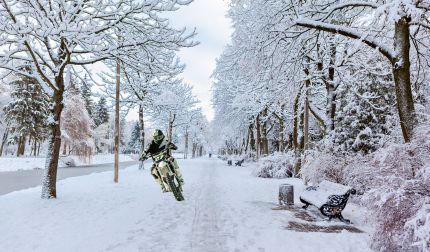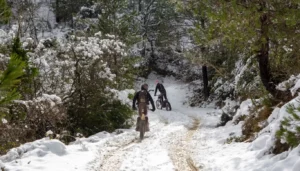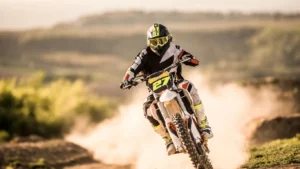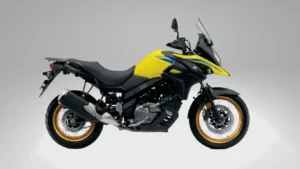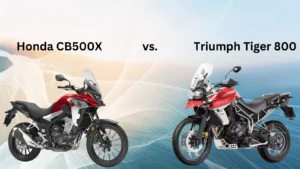If you’re a thrill-seeker who loves off-roading, then dirt bikes outfitted for snow riding will open an entirely new winter wonderland for you. Imagine cutting through the fresh, powdery snow, the cool wind brushing against your face while you maneuver your favorite trails, now blanketed in pristine white.
A whole new level of rejuvenating and adrenaline-pumping action awaits you! The key is finding the right bike to handle the unique challenges presented by the snow. In this article, we’re going to explore the top 5 dirt bikes for snow riding that will grant you an unforgettable winter adventure.
Conquer the Winter Wonderland: Top 5 Dirt Bikes for Snow Riding
- Yamaha WR450F
- KTM 450SX-F
- Honda CRF450R
- Suzuki RM-Z450
- Kawasaki K
Braving the winter elements on a dirt bike isn’t for the faint-hearted. You, an adrenaline junkie, comprehend that winter isn’t an inhibitor but a thrilling challenge. It’s time to strap on your helmet, pull on your gloves, and rev up your engine. After all, nothing beats the cold like hitting the snowy trails on a reliable bike. As such, we’re here to assist you in finding the perfect ride. Let’s take a look at the first bike on our list.
1. Yamaha WR450F
If you’re in the pursuit of the perfect dirt bike to conquer snow-covered wilderness, the Yamaha WR450F deserves your serious attention. This monstrous piece of machinery is celebrated for its exceptional performance and unparalleled durability, ensuring you have a thrilling adventure every single time.
Engine Specification
The Yamaha WR450F boasts a large-capacity 449cc, four-stroke engine offering an infinitesimal balance of power and performance. Its compact design isn’t to be underestimated, packing a punch that delivers smooth, consistent power even in the icy grips of winter.
Suspension and Handling
With the WR450F, enjoy a bike designed to glide effortlessly over uneven, icicle-ridden terrain. Equipped with fully adjustable suspension, it boasts both impressive high-speed stability and low-speed handling comfort. This mangaes the delicate balance of providing an exciting ride without compromising on rider safety.
Endurance and Durability
The Yamaha WR450F showcases not just power, but a resilience unprecedented in the realm of dirt bikes. Crafted with the brand’s renowned exacting standards, every part of this bike is optimized to withstand harsh wintry conditions. And with a cutting-edge fuel injection system, there’s no need to worry about your ride stalling out in the sub-zero temperature.
Pros & Cons
| Pros | Cons |
|---|---|
| Yamaha WR450F’s lightweight design and optimized geometry offer incredible handling performance on snowy tracks. | Despite its top-notch performance, this model might be a little too intimidating for beginners due to its immense power. |
| It has premium-level suspension features that provide excellent shock absorption and stability on uneven surfaces. | The maintenance and spare parts for this premium model could be expensive and hard to find in certain regions. |
| Equipped with an enduring and robust engine that ensures longevity and power delivery even under extreme weather conditions. | Its aggressive power delivery is impressive; however, it requires exceptional rider skill to navigate snowy terrains effectively. |
| Excellent fuel management provides impressive range and efficiency, making it ideal for long snow-riding sessions. | The premium features and capabilities come with a high price tag, making it a slightly pricier option compared to other models in the segment. |
2. KTM 450SX-F
Next on our list we welcome the KTM 450SX-F. A snow-riding powerhouse, KTM 450SX-F boasts a compact yet powerful engine, known for its superb speed and exceptional control on snowy terrain. Ideal for snow bike riders who dare to push the boundaries, the 450SX-F is a natural choice for those who crave both performance and precision.
Engine Power and Performance
The KTM 450SX-F is equipped with a robust 450cc engine, laying the groundwork for its impressive performance. This engine, characterized by its compact design and soaring speed, knows no limits when it comes to snow riding. Soft snow, compacted ice, or rough terrain – the KTM 450SX-F powers through, offering you an unmatched riding experience.
Suspension and Steering Mastery
KTM’s advanced suspension system offers unparalleled flexibility and steerability, adapting effortlessly to changing terrains and harsh winter conditions. Riding the KTM 450SX-F, you’ll feel an immense control and balance, ensuring each ride is not just safe, but also incredibly enjoyable.
Endurance and Robustness
The KTM 450SX-F goes one step further with superior endurance that’s hard to come by. The bike’s construction offers a blend of strength and versatility, aptly designed to resist the harsh conditions of winter. Handling snow, ice, and slush with impressive resilience, this bike surprises with every ride.
Pros & Cons
| Pros | Cons |
|---|---|
| The KTM 450SX-F offers supreme power with its high-performing engine, giving riders an edge while navigating in the snow. | Its power might, however, be challenging for novice riders or those not used to handling hefty horsepower in tricky terrains. |
| Its tight suspension and sensitive steering make for excellent maneuverability on uneven, snowy surfaces. | Some riders might find the suspension too stiff, leading to a possibly uncomfortable ride on long stretches. |
| The bike’s robust endurance allows it to endure harsh wintery conditions, making it a reliable choice for snow riding. | Despite its durability, the KTM 450SX-F requires consistent maintenance due to its high-performing nature, which can be costly over time. |
3. Honda CRF450R
Marking its territory in the realm of snow riding, Honda CRF450R embodies strength, dexterity, and robustness in one dynamic package. This highly rated bike is recognized for its sophisticated suspension, responsive handling, and enduring resilience, proving to be an indomitable horse amidst snow-covered landscapes.
Engine Specification
The Honda CRF450R is built around a highly potent 449cc liquid-cooled single-cylinder four-stroke engine. This spark-ignited machine boasts a nearly unparalleled energy output, manifesting a truly exhilarating riding experience. Plus, thanks to its Programmed Fuel Injection (PGM-FI), this dirt bike guarantees an enhanced fuel economy along with superior performance.
Suspension and Handling
The bike comes designed with a 49mm fully adjustable leading-axle inverted telescopic Showa coil-spring fork for the front suspension, which delivers fantastic shock absorption. The Pro-Link® Showa single shock swingarm provides for the rear suspension which aids in a seamless ride over rough snowy terrains. The result? An unfaltering steadiness, making for a surprisingly comfortable ride.
Endurance and Durability
Crafted with an aluminum twin-spar frame and swingarm, the Honda CRF450R is designed to endure extreme weather conditions and challenging terrains, particularly those inundated with snow. The bike’s powerful braking system, featuring twin-piston calipers, further adds to its durability, providing riders consistent stopping control in snowy conditions.
Pros & Cons
| Pros | Cons |
|---|---|
| The Honda CRF450R has a robust engine specification, perfect for surviving and even excelling in snowy conditions. | Despite having a powerful engine, it is known to consume a significant amount of fuel, which might be an issue for long rides. |
| This dirt bike’s suspension and handling are designed for unpredictable and challenging terrains, making it a safe and trustworthy choice for snow riding. | The bike may feel heavy and less nimble for some riders, affecting their overall riding experience. |
| The CRF450R is praised for its excellent durability and endurance in challenging weather conditions. | Some users have reported issues with the bike’s clutch performance over time. |
4. Suzuki RM-Z450
Turning our spotlight to the 4th champion on our list, let’s delve into the dynamic world of the Suzuki RM-Z450. This snow-friendly beast focuses on delivering flagship performance while maintaining optimal balance of power, control and reliability – perfect for hard-hitting snow riders who love pushing limits.
Engine Performance and Specification
The impressive Suzuki RM-Z450 model is powered by a robust, 449cc 4-stroke, liquid-cooled, single-cylinder DOHC engine. This translates to a tempest of raw power, seamlessly blending with exceptional torque range – a snow rider’s dream come true.
Suspension and Handling Mastery
Equipped with top-tier SHOWA suspension systems, the RM-Z450 offers a plush and controlled ride, even on the slippery trails of your winter wonderland. Its handling is bolstered by Suzuki’s twin-spar aluminum frame, ensuring greater cornering performance and overall stability.
Durability and Resilience
With a proven track record in rugged terrains, the RM-Z450 stands out in terms of durability. Its components have been tested and designed to withstand harsh conditions, providing long-term reliability whether you’re riding leisurely in the snow or tackling aggressive off-road challenges.
Pros & Cons
| Pros | Cons |
|---|---|
| Equipped with a powerful 449cc engine for swift performance | Fuel management may be challenging in colder temperatures |
| Exceptional suspension and handling capabilities | The maintenance of the Suzuki RM-Z450 can be quite high |
| Lauded for its durability and resilience | Can be slightly heavier than some competing models |
| Comes with an easy-start system, making cold morning starts a breeze | Certain parts may be difficult to source |
5. Kawasaki K
Engine Specification
Get ready to roar through the snowy terrain with the ultimate powerhouse, the Kawasaki K. Its commanding presence is backed up by impressive engine specifications. Kawasaki K’s engine leverages a 4-stroke, 1-cylinder, DOHC, water-cooled system that delivers unrivaled power and performance, perfect for the challenging conditions of winter riding.
Suspension and Snow-Riding Abilities
What sets Kawasaki K apart is its phenomenal absorption of shocks and smooth navigation amidst the snow. The front suspension utilizes a 49mm inverted coil-spring fork, which is fully adjustable and perfect for a winter ride. The bike’s rear suspension comes with a new Uni-Trak® system, which not only aids in creating a smoother ride but also imparts additional stability under extreme conditions.
Endurance and Durability
If there’s one thing Kawasaki K doesn’t compromise on, it’s endurance and durability. Built to withstand the harshest winter conditions, it’s your reliable partner through frosty trails and slippery slopes. With a robust structure and high-quality materials used throughout, the Kawasaki K dirt bike is designed to face any winter riding challenge head-on.
Pros & Cons
| Pros | Cons |
|---|---|
| Highly adaptable to snowy terrain due to its adjustable suspension. | Slightly heavier than some competitors, which might affect maneuverability in deep snow. |
| Powerful engine that maintains performance in cold temperatures. | It’s fuel consumption rate might be higher due to the powerful engine. |
| Excellent durability and endurance, built to withstand harsh winter conditions. | May need extra maintenance attention due to the impact of winter environments on parts and components |
| User friendly for both beginner and experienced riders. | The cost of the Kawasaki K can be slightly higher than other bikes in the same segment. |
Conclusion
As the chilly gusts of winter blow in, don’t let the snow curb your adventure spirit! With these top 5 dirt bikes, specifically designed for snow riding, you can make the most out of this winter season. Each one, from Yamaha WR450F to Kawasaki K, comes packed with powerful engine specs, superior suspension systems, and remarkable endurance, ensuring a thrilling yet safe snow ride.
In conclusion, whether you’re an adrenaline junkie or a seasoned trail rider, these bikes are sure to deliver an exhilarating experience. Keep in mind their unique pros and cons when choosing, and prepare yourself for an unparalleled ride through the winter wonderland!
